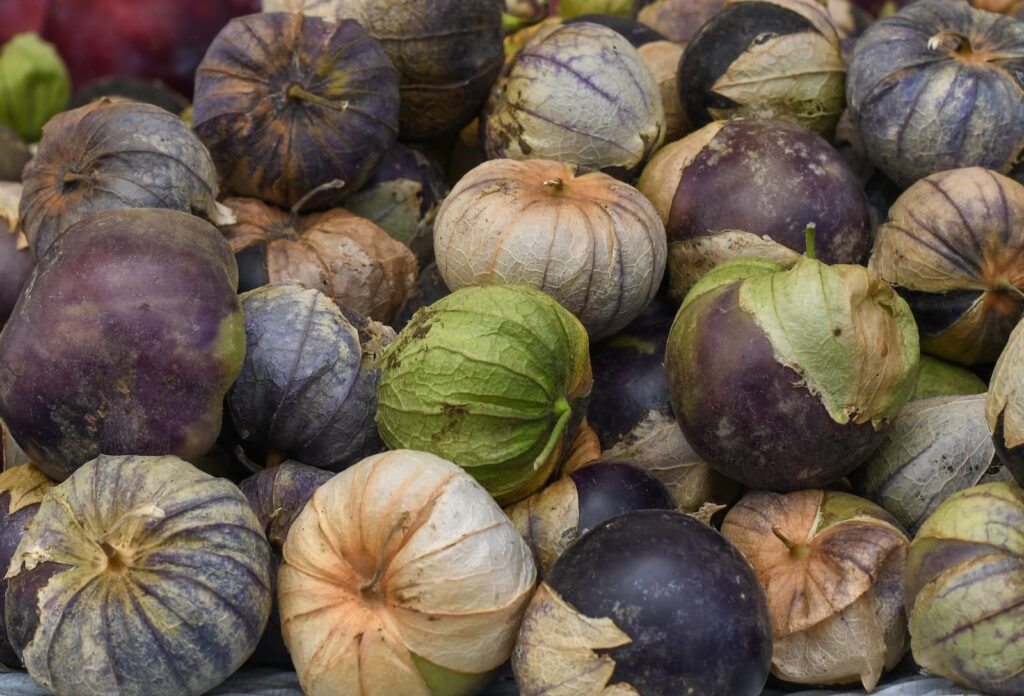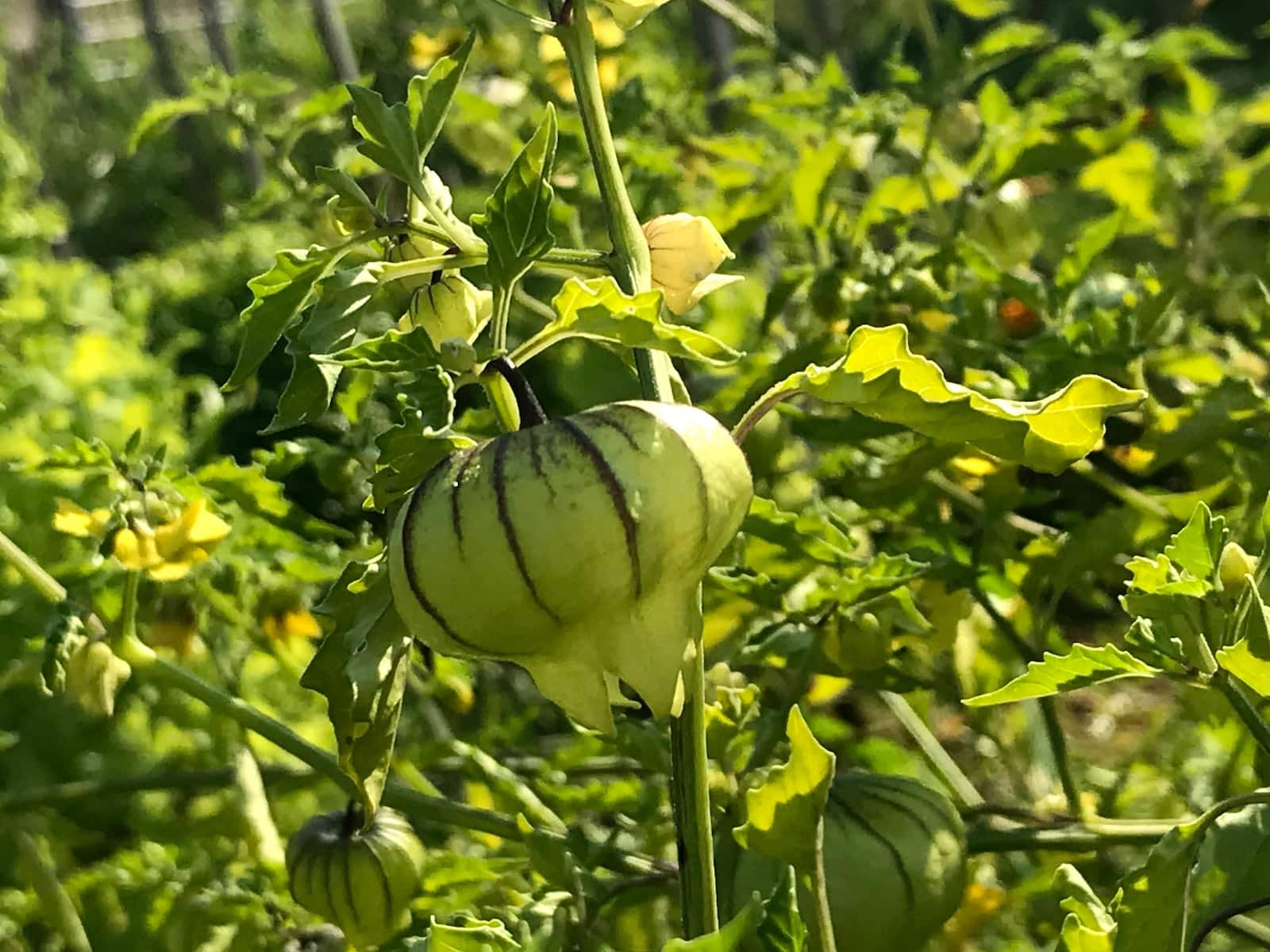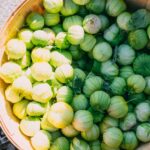Have you ever tasted the sweet-tangy flavor of a tomatillo? These little green gems are gaining popularity in the world of home gardening, and for good reason! The small size and unique flavor make them a great addition to any garden. But have you considered growing your own tomatillos? If so, this guide is the perfect resource for you! Read on to find out all about tomatillos – from planting to harvesting.
If you’re looking for an easy-to-grow crop with big rewards, look no further than the humble tomatillo. Rich in nutrients and bursting with flavor, these “super fruits” have been cultivated in Mexico since pre-Columbian times. Now, they’re becoming increasingly popular here in North America as well. With just a few steps, you can grow your own tomatillos right in your backyard or balcony!
Tomatillos are not only delicious but also surprisingly easy to grow. With a bit of knowledge and effort, even beginner gardeners can succeed at growing their own tomatillos – and reap the rewards of fresh fruits throughout the summer months. So if you’re ready to learn more about this amazing plant, then let’s get started!
1. What Are Tomatillos?
Tomatillos, also known as husk tomatoes, are an ancient Central and South American plant that has been cultivated for centuries. Surprisingly, they are not related to tomatoes, but rather to the cape gooseberry. Today, tomatillos are becoming increasingly popular in North America; in fact, it’s estimated that their sales have grown by 10 percent annually since 2004.
Essentially, tomatillos look like small green tomatoes encased in a papery husk. Inside the husk is a tart-tasting fruit with a sticky coating. When cooked, they become sweeter and can be used as an ingredient in many dishes. Plus, they contain high amounts of vitamin A and C along with potassium and fiber.
Not only are tomatillos tasty, but they are also easy to grow at home. With the right climate and soil conditions, you can expect a bumper crop of these delicious fruits within just two months! So why wait? Let’s get started on choosing the right tomatillo variety for your garden!
2. Choosing The Right Tomatillo Variety
It’s time to roll up our sleeves and get into the nitty-gritty of tomatillo varieties. Before we dive in, it’s essential to understand that there’s no one-size-fits-all solution when it comes to the perfect tomatillo pick. To make sure you don’t miss a beat, it pays to know what your options are. In other words, knowledge is power!
When it comes to selecting your tomatillo variety, you’ll have plenty to choose from. There are small, sweet varieties like ‘Toma Verde’ and ‘Little Sweetie’, as well as large types such as ‘Purple de Milpa’ and ‘Jumbo’. Each option offers its own unique flavor profile and texture. If you’re looking for something spicy, try the classic green husk tomato or the orange-hued ‘Toma Roja.
The ideal tomatillo variety will depend on what you plan on using them for in the kitchen. If you want something that won’t take over a dish, go with one of the smaller varieties since they tend to be less acidic and more sweet. For dishes where you want a bolder punch of flavor and texture, opt for larger tomatillos like ‘Purple de Milpa’ or ‘Jumbo’. Whichever way you go, remember that with a little research and patience, you’ll find your perfect tomatillo match!
3. Starting Tomatillos From Seeds
Do tomatillos actually grow better from seeds than from plants? While many people would argue that starting a plant from seed is the best way to ensure healthy growth and a plentiful harvest, this isn’t necessarily the case when it comes to tomatillos. Starting tomatillos from seeds is definitely an option, but it’s important to know what you’re getting into before you begin.
Growing tomatillos from seeds requires patience and dedication. First, you’ll need to select the right variety of tomatillo for your needs. Some varieties are more suited for warmer climates, while others can handle colder temperatures. Once you’ve made your selection, it’s time to start planting. You’ll need to prepare the soil in advance by adding organic matter and ensuring proper drainage. After that, it’s time to sow the seeds in small pots or trays and cover them with a thin layer of soil. Keep the soil moist and warm until germination occurs- usually within two weeks.
Once your plants have sprouted, you’ll want to transfer them into individual pots or directly into your garden bed outdoors. When transferring them outside, be sure to harden off the plants first by gradually increasing their exposure to outdoor temperatures over a period of several days. This will give them time to adjust and help prevent transplant shock which can harm their growth potential. With careful attention and regular care, growing tomatillos from seed can be a rewarding experience!
4. Preparing The Garden Soil For Tomatillos
Once your garden soil has been prepped and the seeds are ready to go, it’s time to get planting! Picture a garden bed with freshly tilled soil, trowel in hand and tomatillo seeds at the ready – yep, it’s time to get gardening.
But before you start sowing your precious little tomatillo babies into their new home, there are a few important things to consider. First off, you’ll want to make sure that your soil is well-aerated and drains well. If it doesn’t drain properly, tomatillos won’t thrive. Additionally, most tomatillos appreciate a slightly acidic pH level in the soil – between 5.5 and 7 should work just fine. Finally, don’t forget to mix in some organic matter like compost or manure when planting – this will help enrich the soil and give your plants a healthy boost of nutrients.
Now that you’ve got all of these elements in place, it’s time for the final step: getting those seeds planted! With everything prepared ahead of time, this should be a breeze – just remember to keep an eye on those seedlings as they sprout up so they can continue growing big and strong.
5. Spacing Tomatillo Plants
The tomatillo journey continues, with the next step being creating just the right spacing for each plant. Picture a garden patch filled with a multitude of tomato plants, spaced out perfectly to ensure that each one gets its own space to grow and thrive. This is the same concept when it comes to planting tomatillos.
When it comes to spacing, you should leave 18 to 24 inches between each plant. This will give them enough room to spread their roots and reach out for nutrients in the soil. It will also provide sufficient air circulation around each plant, allowing them enough oxygen and light that they need in order to grow large and juicy tomatillos.
Now that your garden soil has been prepared and you have the perfect spacing between plants, it’s time to move on to the next essential factor in growing tomatillos – water requirements.
6. Water Requirements For Tomatillos
Water is the lifeblood of any garden – and tomatillos are no exception. Like a quenching rain, it brings new life and vigor to your tomatillo plants. While too much water can be detrimental, finding that perfect balance is essential for success.
When it comes to watering tomatillos, consistency is key: keep their soil evenly moist but not soggy. In other words, it’s best to err on the side of under-watering than over-watering. This means checking the soil around each plant often to ensure that it’s moist but not wet. Deep watering every five to seven days should be sufficient in most conditions.
If you live in a particularly hot or dry climate, however, you may need to water more frequently or even set up a drip irrigation system for proper hydration. With the right amount of water, your tomatillo plants will thrive and reward you with an abundant harvest! Now let’s look at how best to fertilize them for optimal growth.
7. Fertilizing Tomatillos
In order to get the best yield of tomatillos, it’s important to properly fertilize them. According to experts, a general rule is that one pound of fertilizer should be applied for every 100 square feet of garden bed. It’s essential to choose the right type of fertilizer for tomatillos. Most plants prefer an organic or slow-release fertilizer that contains nitrogen, phosphorus and potassium in balanced amounts.
Fertilizing tomatillos regularly will help them produce more fruit and stay healthy throughout the growing season. A good practice is to apply fertilizer every two weeks or so during the peak growing months from late spring through summer. To avoid over-fertilizing and risking burning the plant, it’s important to follow the directions on the fertilizer package carefully and use less than recommended if you’re uncertain about how much to apply.
Another tip is to mix compost into soil around tomatillo plants before planting and once a month during their growth cycle. Compost helps improve soil structure, adds nutrients and provides organic matter which helps retain moisture in the soil. This can help optimize water absorption while providing essential nutrients for healthy growth and greater yields of tomatillos. With these fertilization tips in mind, let’s move onto controlling pests and diseases of tomatillos.
8. Controlling Pests And Diseases Of Tomatillos
Protecting your tomatillos from pests and diseases is paramount for a successful harvest. Properly managing pests and illnesses is key to cultivating plump and juicy fruits. From tiny bugs to troublesome fungus, here are eight tips for controlling these hazards.
First, monitor all stages of growth of tomatillos carefully. Inspect foliage, stems and fruits regularly for signs of damage or distress. Second, if you notice any holes in leaves or fruit, it’s likely an insect infestation. Use insecticidal soap to immediately kill any bugs on contact. Third, keep in mind that the best form of pest control is prevention; use row covers or garden fabric to protect your tomatillos from flying insects like moths or aphids.
Fourth, as with most garden plants, companion planting can be beneficial for natural pest control; plant marigolds near tomatillos as their pungent aroma can deter many insects. Fifth, since too much water can lead to the spread of fungal diseases like blight or mildew, make sure the soil around your tomatillo plants drains well and irrigate only when necessary. Sixth, remove diseased foliage promptly as it’s important not to let the disease spread further into the plant’s system. Seventh, if needed apply a fungicide to help halt disease spread in your plants as soon as possible.
Finally, when mildew does set in on your tomatillo plants try using a baking soda solution with water to spray down affected areas; this could potentially prevent any further damage and help restore your tomatillo crop back to health! With these helpful tips in mind you’ll be ready to start harvesting tomatoes soon!
9. Harvesting Tomatillos
When the time comes to reap the rewards of your hard work, harvesting tomatillos is an exciting experience – almost like opening a surprise. Picture the sun shining down on your garden, with plump and juicy fruits ready to be collected.
To harvest tomatillos correctly, wait until they turn a golden-yellow color. At this point, they should easily separate from the plant with a gentle tug. If they feel tough or don’t come off easily, leave them for another day or two. When ready to pick, cut the stem just above the fruit instead of pulling it off. Even if some of the skins have split open, you can still harvest them and use them in recipes.
Once harvested, you’ll want to store tomatillos properly so that you can enjoy their unique flavor for as long as possible. For best results, wrap them in paper towels and place them in an airtight container before storing in the refrigerator for up to two weeks.
10. Storing Tomatillos
Storing tomatillos properly is paramount to preserving their powerful flavor. Plucked from the plant with care, these tart treats can last for weeks when stored correctly. Crafting cleverly constructed containers for your crop ensures that you’ll enjoy your bounty for as long as possible.
First and foremost, keep tomatillos cool and out of direct sunlight. Wrap them in a damp paper towel and store them in the refrigerator on the top shelf. To maximize their life expectancy, be sure to place them in an airtight container or plastic bag. The more airtight the packaging, the better! This will also help prevent any cross-contamination of other items in the fridge.
For longer-term storage needs, freezing is a viable option to maintain their deliciousness. Wash and husk off any leaves or stems before popping them into freezer-safe bags. You can also blanch them before freezing if desired; simply dip them in boiling water for 1 minute before submerging them into an ice bath and drying thoroughly before bagging up.
With a few smart moves, your tomatillos will remain fresh and flavorful until you’re ready to cook with them!
11. Cooking With Tomatillos
Tomatillos are a unique and flavorful addition to many dishes, and adding them to your cooking can be both fun and delicious. Take the case of Maria, who was looking for an interesting way to spice up her tacos. She decided to try making them with tomatillos, thinking that their tangy flavor would be a great contrast with the spiciness of the taco filling. She went out to her garden and picked some tomatillos, which she then cooked with onion, garlic, and spices to make a delicious salsa. Her tacos were a big hit!
Cooking with tomatillos is actually very easy. They can be used in sauces, salsas, soups, chilis, stews, or even just eaten raw as a snack. Tomatillos are also often used as an ingredient in guacamole or pico de gallo. They can also be roasted or fried in oil until they’re lightly browned and slightly crunchy – perfect for sprinkling over tacos or salads. No matter how you decide to prepare them, tomatillos are sure to add flavor and excitement to any meal.
Tomatillos are incredibly versatile when it comes to cooking – so why not give them a try? With their unique taste and texture, you’re sure to find something new and delicious each time you cook with them! Now that we’ve discussed cooking with tomatillos, it’s time look at propagating them for your own home garden.
12. Propagating Tomatillos
Propagating tomatillos is like a dance, with each step carefully choreographed to ensure success. First, purchasing the right variety of seeds or seedlings is essential. Tomatillo plants are easily found at nurseries or can be ordered online from seed catalogs. When choosing seeds, it’s important to look for those that are certified organic and non-GMO.
Once you have the seeds or seedlings, you’ll need to prepare the soil for planting. Tomatillos prefer slightly acidic soil with plenty of organic matter. A good way to achieve this is by mixing in compost before planting the seeds or seedlings. Planting depth should be about two inches deep and spaced three feet apart in rows that are at least four feet apart.
Watering is a key factor in successful propagation; tomatoes need to be watered regularly but not overly so as too much water can lead to root rot and other diseases. The best way to determine if your tomatillo plants need water is by feeling the soil; if it’s dry then it’s time for a drink! With enough attention and care, your tomatillo plants will soon be producing beautiful fruit ready for harvesting.
13. Companion Planting For Tomatillos
Did you know that companion planting can increase yields by as much as 20%, as well as reduce pests and diseases? That’s why it’s important to give your tomatillos a helping hand. In this section, we’ll look at how to companion plant for tomatillos.
Companion planting is the practice of strategically planting certain crops together to help each other thrive. Tomatillos are known to be great companions with carrots, parsley, dill, beets, and potatoes. They also do well in the presence of cabbage family vegetables like broccoli and cauliflower. Additionally, garlic and onions can help protect tomatillo plants from some diseases.
Planting flowers nearby can also be beneficial. Marigolds are especially helpful because they repel harmful insects while attracting beneficial ones like bees, hoverflies, and lacewings – which all play a role in controlling pest populations. Planting herbs such as oregano or basil near your tomatillo plants may also be beneficial since these too have insect-repelling properties.
With these companion planting tips in mind, you should now have a better idea of how to optimise your tomatillo crop’s performance! Now let’s move on to troubleshooting common issues when growing tomatillos…
14. Troubleshooting Tips For Growing Tomatillos
Growing tomatillos can be rewarding, but it is not always problem-free. In this section, we will discuss some of the common problems that can arise and how to trouble-shoot them.
The most common problem with growing tomatillos is dealing with pests and diseases. This can be prevented or minimized by using companion plants like basil or oregano in your garden. These herbs will help attract beneficial insects that can ward off some of the more damaging pests. Additionally, make sure to keep an eye out for any signs of disease and take action quickly if you spot any unusual symptoms on your plants.
If you’re still having trouble, try adjusting the soil pH to a slightly acidic level (around 6–7). This should help ensure that your tomatillos are receiving all the necessary nutrients they need to grow properly. Additionally, make sure you’re providing enough water and sunlight – tomatillos need plenty of both! With a bit of care and attention, you should have no issue growing healthy tomatillos in your garden.

15. Reaping The Benefits Of Growing Tomatillos
Growing tomatillos is like finding a secret garden, one that produces an array of flavorful and colorful treats. Reaping the benefits of growing tomatillos offers a unique opportunity to enjoy the fruits of your labor.
The rewards are plentiful. You can create your own salsa verde or even roast the tomatillos to use in dishes like tacos and quesadillas. Tomatillos also contain vitamins A, C, calcium and iron, making them a great addition to your diet.
Harvesting at the right time is key; when the skin begins to wrinkle and split from the husk, it’s time to gather them up for cooking and eating! With proper care and maintenance, you’ll be able to enjoy the delicious rewards of all your hard work in no time.
Frequently Asked Questions
How Much Sun Do Tomatillos Need?
Tomatillos are a beloved ingredient in many dishes, but growing them can be tricky. If you’re looking to get the biggest and best tomatillos, it’s essential to understand their light requirements. So, how much sun do tomatillos need?
Well, tomatillos love the sun! They should be planted in an area that receives full sun for six to eight hours each day. To maximize growth and fruiting potential, try to pick a location that is sheltered from wind and gets plenty of afternoon shade during hot summer months. It’s also important to note that they prefer well-draining soil with a pH level between 6.0 and 7.0.
Finally, tomatillo plants need regular watering in order to thrive. The soil should be kept moist but not waterlogged; aim for about an inch of water per week during the growing season. Mulching around the base of the plant will help conserve moisture and keep weeds at bay. With the right conditions, you can enjoy sweet, juicy tomatillos all summer long!
How Often Should I Water Tomatillos?
The lifeblood of any garden is water, and the same goes for tomatillos. Nurturing these delicious veggies requires a careful balance of moisture to ensure their health and flavor. So how often should you water tomatillos? Let’s dive in!
Water is the key to unlocking a bountiful harvest of tomatillos. It’s essential that they get enough moisture without being overwatered. A good rule of thumb is to give them about one inch of water each week, either from rainfall or from your garden hose. You can also use a soaker hose or drip system to make sure that all parts of the plant are getting adequate amounts of water. If it looks like the soil is drying out too quickly, add some mulch around the base of the plant to help retain moisture in the soil.
Tomatillo plants need consistent watering throughout their growing season, but be mindful not to over-water them as this can cause root rot and other issues. There are signs that you can look for that will tell you when it’s time to give your plants some extra TLC – if the leaves look wilted or yellowed, it may be time for a drink! With just a little bit of care, you’ll have delicious green fruits bursting with flavor in no time at all.
Is It Possible To Grow Tomatillos Indoors?
Growing tomatillos indoors is definitely possible – but it requires a bit of extra effort. To make sure your tomatillo plants thrive, you’ll need to provide them with plenty of sunshine and water. That means finding the perfect spot in your home that gets plenty of light, such as near a south-facing window.
Additionally, you’ll need to use a large planter or container that gives the root system enough room to grow. As for watering, it’s best to keep the soil moist but not soggy; this means watering your plant every few days depending on the humidity levels in your house. If water is allowed to stand around the base of the plant, it can cause fungal diseases which can kill off the roots and leaves.
It’s also important to use quality potting soil; look for one that is light and fluffy so that it will retain moisture without becoming too soggy. Additionally, adding some organic matter like compost or worm castings is a great way to give your tomatillos an extra boost. With just a bit of extra care and attention, you’ll be enjoying delicious tomatillos from your own indoor garden in no time!
How Do I Know When Tomatillos Are Ripe?
Ripe tomatillos are like hidden gems waiting to be discovered – their vibrant green husks hiding a sweet and tart surprise. But how do you know when they’re ready to pick?
When the tomatillos have filled out their husks, they become smooth and firm to the touch. The fruit will be slightly smaller than an apple, usually about two inches in diameter. You’ll also notice a change of color from green to a yellow-brown shade that indicates ripeness. To make sure your tomatillo is ripe, try gently pressing the husk; if it gives slightly under pressure, then it’s ready for harvesting.
If you’re growing indoors, keep an eye on their progress by checking the size and texture daily. With some patience and practice, you’ll soon be able to tell when your tomatillos are ripe without having to guess. It should also be noted that while picking your fruits too early can negatively affect flavor, leaving them on the plant too long can cause them to split or spoil due to over-ripening.
Knowing when your tomatillos are at their prime is key for getting the best flavors out of this delicious Mexican staple. With a few simple tips and tricks, you can easily learn how to spot when these little gems are ready for harvesting!
What Is The Best Way To Store Tomatillos After Harvesting?
Storing tomatillos properly after harvesting is key to preserving their flavor and texture. Tomatillos should be kept in a cool, dry place, such as the refrigerator or a dark pantry. It’s important to keep them away from direct sunlight, as this can cause them to spoil quickly.
When storing tomatillos, it’s best to leave the husks on until you are ready to use them. This helps keep the fruit fresh for up to two weeks. Once you have removed the husk, it’s important to store the tomatillos in an airtight container so that they don’t dry out. If you plan on using them within a few days, you can leave them at room temperature and cover with plastic wrap or wax paper.
To ensure maximum freshness, it’s best to use your tomatillos as soon as possible after harvesting. If you need to store them longer than two weeks, freezing is an option. Place washed and dried tomatillos in a freezer-safe container or bag and freeze for up to six months. When ready to use thawed tomatillos, cook before serving as this will help retain their flavor and texture.
Conclusion
Tomatillos are a unique and delicious addition to any garden. With proper care and attention, they can produce large yields of flavorful fruit. Not only that, but they require very little space to grow, making them an ideal crop for small gardens.
Growing tomatillos is not difficult once you know the basics. They need plenty of sunlight, regular waterings, and good soil to thrive. Additionally, you should make sure to harvest tomatillos when they’re ripe—an interesting statistic is that 90% of tomatillos are ready to be picked within 50 days after flowering.
Proper storage is also important if you want your tomatillos to last for several weeks or months. Refrigeration is the best way to store them; however, freezing is another option if you want to save your harvest for future use.
All in all, growing tomatillos requires minimal effort with maximum rewards! With just a few simple steps, you can enjoy a steady supply of these delicious fruits for many years to come.





























